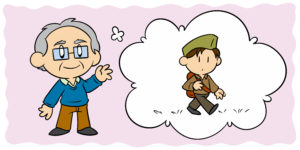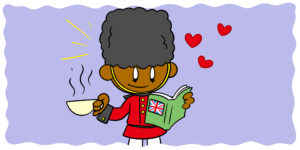Kate Bernheimer is like fiction’s knight errant, on a mission to rescue fairy tales from the tall, dark tower where they’ve been locked away with other vestiges of childhood – like optimism and the color pink.
Bernheimer’s writing style is magical and her modern fairy tales are understandably popular, but the average writer may think they don’t have much to learn from her unless they’re trying to do something similar.
They’d be mistaken. Bernheimer’s literary philosophy has universal applicability. Here’s why.
1. Fairy tales are the blueprint for reading… and writing
Fairy tales hold the secret to reading.
– Kate Bernheimer, ‘Introduction’ from My Mother She Killed Me, My Father He Ate Me
To pick Kate Bernheimer’s brain, one needs look no further than her eloquent and compelling introduction to the fairy tale anthology My Mother She Killed Me, My Father He Ate Me, wherein she claims that ‘fairy tales hold the secret to reading’ – perhaps because, as she also asserts, ‘all great narratives are great fairy tales… whatever their shape.’ This last comment is an expansion of Vladimir Nabokov’s well-loved quote: ‘all great novels are great fairy tales.’ Using this claim as a lens, we can see the hidden fairy tale in Nabokov’s best-known work, Lolita: once upon a time, an evil ogre with just a touch of socio-ethical complexity fell in love with a beautiful, innocent girl and affected her life in a way that would have to be seriously cleaned up for the Disney version.
But what about Bernheimer’s claim that all narratives are fairy tales? Why is this sub-genre, so often labeled ‘children-only,’ supposedly so influential? For one thing, a culture’s fairy tales are ingrained in their mental and creative infrastructures. When writing a story, it is impossible for an author to escape these deep-seated motifs. Every author takes pen to paper with a cultural history behind each story, so that every character either resembles or does not resemble Cinderella. When Cinderella is a character archetype in the authors’ and readers’ collective memory, it cannot be any other way.
All fairy tales are narratives, but are all narratives fairy tales? Yes or no, it’s a useful theory…Click To TweetLook at it from the opposite direction: if you watch Atanarjuat with no knowledge of Inuit culture, you won’t get as much out of it. Many viewers will still find it enjoyable (albeit a bit long for some tastes,) but the layers of meaning in this age-old myth will remain largely unwrapped. Everything born into a culture, usually through the stories that culture tells to its children, remains an intimate part of its storytelling tradition well into adulthood and across generations.
At the same time, the structure of the fairy tale is universal and therefore incredibly flexible. From a culture as foreign to most non-Inuit viewers as a Martian landscape comes a remarkably familiar plot:
The story [of Atanarjuat] itself, like the story of all great myths, is both very simple and very complex. Evil comes into the lives of a family. People who depend on collaborating with one another become enemies. The source of this enmity is shamanic: a mysterious stranger… The drama of the enmity is love…
– Hugh Brody, ‘Atanarjuat – The Runner’
We’ve seen all of this countless times before. Harmony, relationships, conflict, rising tension, tragedy, resolution. The structure of a story is first imparted to us in fairy tales. And when, in our mundanely pragmatic adult lives, we forget it, the simplicity of the fairy tale carries us back to it.
For a reader, or writer, to understand the place of fairy tales in our world is to uncover the secret: every story is a new take on the old, the eternal, the fairy tale story arc: once upon a time… the end.
2. Just because it didn’t happen doesn’t mean it isn’t true
Fairy tales comprise thousands of stories written by thousands of writers over hundreds of years… In combination with terrifying holocaust footage screened at my temple, and stories of burning bushes, singing “spring turtles,” and parting seas – the consolation of magical stories was directly imprinted on me.’
– Kate Bernheimer, ‘Introduction’ from My Mother She Killed Me, My Father He Ate Me
Fairy tales touch on the human condition. The elements of risk, love, jealousy, revenge, and fidelity persist even in Disney’s G-rated retellings of all things Grimm. And if you read true tales of courage and integrity in the face of unspeakable evil, real life’s resemblance to fairy tales is unmistakable. Bernheimer points out this parallel:
When I first read Anne Frank’s Diary of a Young Girl, I saw for the first time that a girl could be a writer and that it had something to do with survival and with ethics and fighting against evil. I admired her, though her diary remained terrifying and mysterious to me. She was a character in a real fairy tale – fairy tales are brutal.
– Kate Bernheimer, ‘Kate Bernheimer: Champion of the Fairy Tale,’ The Sisterhood
True stories of the holocaust tie Jewish readers to their history and remind others what it means to act with integrity – and without. Fairy tale stories are like scale models of life – reflective of the real. There will be many cycles of harmony, conflict, tragedy, and resolution in life. A fairy tale extracts one cycle and looks at it closely, sees it for the universal human experience that it is, and hangs symbols and pictures and metaphors on it in order to valorize some pretty mucked-up experiences and convey them to the world.
Like dreams, they mingle reality and desire, the sensible and the absurd, in a way that helps our brains process data and emotion. When abandonment, murder, rape, and all forms of human tragedy are presented aesthetically (as fairy tales, say), the resulting aesthetic experience triggers the part of the brain responsible for self-reflection and empathy – qualities that are integral to coping with and resolving human tragedies. For a deep dive into the neuro-philosophy behind art and the human condition, I highly recommend the article ‘The Brain on Art’ and related sources.
Fairy tales allow us to engage with dark themes in an engaging, intelligible way. Click To TweetApart from the brain-reasons as to why this happens, people have known from The Beginning (for which every culture has a myth) that stories are important. They bring us together, they teach practical and ethical lessons, they help us cope, they entertain us, they are a palatable medium for otherwise weighty discourse, they are archetypal and – in Kate Bernheimer’s terminology – ‘sensual’; in short, they are timeless. In conveying the essence of human experience, even the most preposterous tales are true.
3. ‘New’ comes from working old things in new ways
When I wrote the eight fairy tales that appear in ‘Horse, Flower, Bird’ I was working toward a completely new form of artistic expression, trying to create a new kind of tale that also felt vintage: innocent and childlike, but haunted. I tried to write a picture-less picture book.
– Kate Bernheimer, ‘Kate Bernheimer: Champion of the Fairy Tale,’ The Sisterhood
There’s nothing new under the sun, but there will always be new ways to say that there’s nothing new under the sun. Even as she espouses the timeless nature of fairy tales, Bernheimer reminds us that a modern take is likely to attract more readers and give a contemporary flavor to an ancient genre.
This method is effective both in terms of creativity and marketability. It’s a smart market move, as other modern-vintage concepts and products have proven quite popular recently. The vintage-style memes, eCards, clothing, light fixtures, and you-name-it in circulation these days are reminiscent of their antique counterparts, but few are identical. The modernized vintage look is something people already have a taste for, so it’s little wonder that the contemporary fairy tale resonates with today’s readers.
A modern approach to traditional narratives can create something fresh.Click To TweetBernheimer is not the only author to have capitalized on this playful and broadly appealing genre. Gregory Maguire, Neil Gaiman, Aimee Bender, and many others have carved out a sizeable corner of 21st-century literature. But the impact is more than salability. The creative value of Bernheimer’s style is unmistakable:
Doll-less, invisible friend-less, finally more comfortable in fear than in gladness, Astrid began to live in her head. Or rather inside a small tunnel – a hole – in her head, through which she watched everything gaily depart. She nodded this head and pretended to listen. “Bye-bye,” she would hear from within.
– Kate Bernheimer, Horse, Flower, Bird
‘It is often the humble to whom magic is revealed’
In grafting novelty onto universal structure and human issues, an author is very likely to find success. Of course, they need not adopt the quirky, ethereal style of overt fairy tales to benefit from what they teach us about writing.
Try writing a contemporary version of a well-loved fairy tale. For a fantastic example of how to subtly adapt ancient writing to a contemporary setting, I can’t over-recommend The Story of Edgar Sawtelle and its olden-days counterpart – which I will not name in the interest of preserving what is, for most readers, a delightful surprise.
Alternatively, hide a fairy tale within your story. Use an existing or original fairy tale as a bare-bones plot, then dress the characters and setting in such a way that suits your knowledge base and intended readership. Whatever unique qualities you bring can shine new light into old corners and bring timeless stories to life… again and again.
Check out A Fairy Tale Retelling Could Be The Best Thing For Your Career and How To Create New Stories By Adapting Famous Books for more great advice on this topic, and try 5 Ways Virginia Woolf Can Help You Improve Your Writing and 5 Ways Maya Angelou Can Improve Your Writing for more suggestions from literary greats.






2 thoughts on “3 Ways Kate Bernheimer Can Help You Improve Your Writing”
According to vocabulary.com, “A fairy tale is a magical story for children.”
That and so much more. 🙂